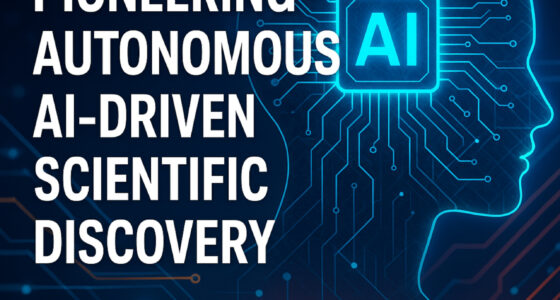Nearly 60% of routine retail knowledge tasks could be automated within a decade, changing how stores operate and how you manage customer experiences.
You are facing a moment where AI agents reshape the rules of retail automation. Platforms like Lumi.new let you describe a site or app in plain language and get a ready-to-edit storefront, blog, or internal tool in minutes. That shift compresses design, content, and deployment into conversational prompts so nontechnical teams can launch customer-facing features without waiting on developers.
At the same time, broader policy choices — from healthcare subsidies to local funding — influence consumer spending power. Those forces determine whether the promise of AI retail transformation turns into higher margins or tighter competition for your store.
Local training programs and partnerships, such as county agricultural and technical institutes, show how workforce development keeps pace when technology arrives. You will need to think about reskilling and new roles that supervise, edit, and govern AI systems as knowledge work moves from people to agents.
Key Takeaways
- AI agents accelerate retail automation by turning conversational instructions into production-ready sites and tools.
- You can use platforms like Lumi.new to reduce development time and enable nontechnical staff to manage digital experiences.
- Macro policy shifts affect consumer demand and the economics of AI retail transformation.
- Local education and training programs are essential to prepare workers for new knowledge roles.
- Retailers must plan for oversight, quality control, and gradual adoption to capture the benefits of a post-labor retail economy.
AI Agents & Knowledge Work: The Post-Labor Retail Economy

You are watching a shift where platforms such as Lumi.new let small merchants build pages and apps from simple prompts. This lowers development cost and speeds rollout. That capability drives retail knowledge automation by turning conversations into production-ready components you can reuse across stores and teams.
Your team can deploy templates and galleries to scale fast. Training comes through documentation, webinars, and live sessions that shorten onboarding. Those reusable elements make AI-driven retail practical for merchants who lack engineering resources.
Policy choices shape demand. When subsidies or tax rules change household budgets, retail spending moves with them. You must track the macro environment and retail AI policy so your planning accounts for shifting customer capacity.
Education and community programs build local talent pipelines you can tap. Practical training in supply chains, construction-adjacent retail, and agricultural sourcing matters when hybrid workflows pair AI agents with human expertise. That mix points to the future of retail labor where knowledge roles work alongside automation.
| Area | What AI agents provide | What people still do |
|---|---|---|
| Content and pages | Convert prompts into live pages, reuse templates | Set brand voice, review and approve final copy |
| Operations | Automate routine reports and routing | Resolve exceptions and manage partnerships |
| Demand planning | Model scenarios tied to policy shifts | Interpret local factors and adjust strategy |
| Workforce development | Deliver training content at scale | Run hands-on community programs and mentoring |
How AI Agents Automate Knowledge Work in Retail
You can use AI agents to shift repetitive knowledge work out of busy teams and into systems that run 24/7. These platforms handle page builds, copy drafts, asset creation, and basic product wiring so designers and merchandisers focus on higher-value choices. The result is faster launches, fewer manual errors, and clearer handoffs between marketing and operations.

Common tasks AI agents take over
AI agents tasks often begin with layout generation and responsive page assembly. They create navigation, forms, and wire components that used to need developers. For content generation, the agents draft product descriptions, promotional copy, and social posts that humans polish for tone and accuracy.
These systems automate merchandising actions, from sorting product feeds to scheduling promotions. Dynamic pricing and targeted campaigns run at scale when markets shift or subsidies change, keeping sales steady while you monitor strategy. Nontechnical conversational builders let you describe features and have the platform duplicate pages, reuse styled elements, and create reusable components without code.
Efficiency gains and tradeoffs speed vs customization
Speed gains are obvious. Near-instant page builds and template-driven personalization cut launch times from weeks to hours. Automated merchandising and routine content generation scale across thousands of SKUs with minimal human input.
You must weigh tradeoffs speed vs customization when you deploy these tools. Templates and reusable components improve throughput but can dilute brand distinctiveness. For deeply bespoke experiences, human designers and engineers remain essential. A hybrid approach works best: let AI agents handle repetitive work while your team injects brand-specific prompts and manual refinements.
Platforms Enabling Nontechnical Creation for Retail Operations
You can build retail sites and apps without deep engineering by using modern no-code AI platforms. These tools let merchants move from idea to live storefront fast. They remove technical bottlenecks so operations teams, merchandisers, and small agencies can iterate on promotions and layouts.

Startups such as Lumi.new show how conversational builders reshape the workflow. You type product needs and design cues into a chat-style interface. The AI returns full pages or a small site with styling, responsive behavior, and sample content. You then tweak theme, layout, and brand assets until the experience matches your goals.
Conversational website and app builders
Conversational builders use natural language prompts to generate landing pages, blogs, and simple e-commerce flows. You describe your catalog, promotions, or audience and receive a near-complete build you can publish quickly.
These builders speed deployment for promotions and seasonal launches. They pair well with analytics and payments integrations that you already use in retail operations. Training formats such as webinars and live sessions help your team adopt the workflow.
Reusable components and template galleries
Reusable components let you save headers, product blocks, and checkout modules for repeat use across stores. Components cut duplication and keep brand standards consistent when multiple people edit content.
Template galleries fueled by community contributions mirror institutional partnerships you may know from universities and industry groups. Those galleries offer domain-specific layouts that are ready to customize for local inventory or seasonal campaigns.
| Feature | Benefit for Retail | Typical Use Case |
|---|---|---|
| No-code AI platforms | Faster site creation with minimal developer time | Pop-up shops, flash sales, local landing pages |
| Lumi.new conversational workflow | Generate full pages from chat prompts, then tweak | Rapid A/B testing of homepages and product collections |
| Conversational builders | Access for nontechnical staff to design experiences | Marketing teams deploying campaign pages |
| Reusable components | Maintain consistency and reduce repetitive tasks | Multi-store brands and agency-managed clients |
| Template galleries | Domain-specific, community-vetted starting points | Seasonal templates, regional merchandising setups |
Impact on Retail Labor: From Store Floors to Knowledge Roles
You will see shifts across roles as AI tools handle routine tasks. Cashier duties shrink while oversight and decision work grows. This change can cause retail job displacement in entry-level positions, yet it also opens paths into higher-skill roles.

Retailers like Walmart and Target that adopt AI site builders cut demand for some front-end and content roles. Your teams will need new responsibilities such as prompt design, brand strategy, and customization oversight. Those tasks require judgment, context, and ongoing edits rather than repetitive work.
Upskilling and workforce development must be deliberate. You can partner with local colleges, technical institutes, and community programs to create short courses in data governance, quality assurance, and customer-success oversight. Live training, webinars, and clear documentation speed adoption.
Shifts in job responsibilities
Employees move from transaction handling to supervision, annotation, and exception management. Store associates may become in-store AI trainers who annotate images or verify recommendations. Supervisors will audit model outputs and set escalation rules.
Upskilling and workforce development
You should design training that matches real tasks. Offer hands-on modules, mentorship, and credentials that mirror roles like data annotator or AI overseer. Local programs that teach applied skills in agriculture or trades can be repurposed to teach technical retail tasks.
Policy shifts that affect consumer spending will change hiring needs. If demand falls, reskilling programs help you redeploy staff into community-facing services or knowledge roles. A blended approach protects livelihoods and preserves institutional knowledge.
Plan workforce development as an ongoing investment. Track progress with simple KPIs: task proficiency, error rates in annotated data, and time-to-competence. Clear career pathways reduce turnover and help you manage the AI impact on jobs while keeping teams motivated.
Economics of a Post-Labor Retail Model

You should view the post-labor retail model as a shift in cost geometry. Platforms that automate site builds and content cut labor input for digital presence. Faster launches and reusable components lower marginal costs for new pages and stores.
For agencies and merchants, this lowers developer hours while keeping conversion-focused design. Training materials and webinars add upfront expense. Those costs spread across many users, improving margins with automation as scale grows.
Cost structures and margins
Startups and small merchants get lower fixed costs from templated sites. You still carry hosting, licensing, and customer-acquisition expenses. When you combine automation with efficient ops, margins with automation widen because variable labor shrinks.
Expect tradeoffs. Custom work increases per-project revenue but reduces hourly efficiency. Your choice between standardized templates and bespoke services shapes gross margin and cash flow.
Pricing, competition, and market concentration
Lower operating costs push retailers to adjust pricing strategies. You can compete on price or on bundled services. If you cut price to chase volume, you risk triggering aggressive price moves from rivals.
Large retailers that invest heavily in automation can scale faster than smaller merchants. This creates pressure toward market concentration as firms with capital capture share through lower prices and broader reach.
External factors matter. Policy changes that affect household disposable income will change demand. When budgets tighten, you must revise promotional mixes and pricing strategies to keep volume without eroding long-term profitability.
Customer Experience When AI Handles Knowledge Tasks
You will see faster, more tailored interactions as merchants deploy AI to generate product pages, emails, and chat replies. AI personalization lets brands push relevant offers to millions of shoppers without building each variant by hand. Conversational prompts let teams set tone and segment messaging so your storefronts feel consistent across channels.

At the same time, you will face new risks that can erode customer trust. Automated CX can surface mistakes in recommendations or tone-deaf responses that look efficient but feel cold. When outcomes affect billing, returns, or health-related purchases, empathy matters more than speed.
To balance scale and sensitivity, maintain human editorial control over critical content. Retailers such as Shopify merchants and Best Buy use human review for product descriptions and curated lists to catch domain errors and preserve brand voice. That oversight improves accuracy and supports a human-AI hybrid experience that blends speed with judgment.
Design clear escalation paths so customers can reach a person quickly when an automated CX answer misses the mark. Offer visible options for human help on sensitive pages and during complex cases. That approach strengthens customer trust and reduces friction when AI gets uncertain.
Below is a practical comparison to guide your approach.
| Area | AI-first Approach | Human-AI Hybrid Approach |
|---|---|---|
| Personalization | Automated CX delivers rapid, data-driven variants across pages and emails. | AI personalization creates drafts that human editors refine for accuracy and tone. |
| Customer Trust | Trust can drop if errors or biased suggestions go unchecked. | Trust improves with transparent AI labels and easy human escalation paths. |
| Handling Sensitive Cases | Fully automated responses risk inappropriate handling of billing or health issues. | Humans step in for empathy while AI preps context to speed resolution. |
| Operational Speed | High throughput and low marginal cost for content generation. | Moderate speed with checkpoints to ensure quality and compliance. |
| Brand Consistency | Templates scale voice but miss nuanced brand cues. | Editors tune AI outputs to keep messaging aligned across channels. |
Regulatory and Policy Considerations for Retail AI Agents
You need clear rules when AI agents set prices, make recommendations, or handle returns. Policymakers are weighing AI regulation retail measures that protect shoppers and preserve market fairness. Transparency in algorithms and data use helps you verify decisions and builds trust with customers.

Start by requiring platform operators to disclose AI-generated content and give shoppers editing controls. If a merchant uses chat agents or automated offers, a visible label and an edit option reduce confusion. Consumer protection should cover misleading claims, hidden fees, and opaque eligibility rules for discounts or subsidies.
Audit trails let you trace how a price or promotion was produced. Regulators may demand logs that show inputs, model versions, and decision paths for offers that affect household finances. That kind of auditability supports both enforcement and merchant accountability.
Labor policy must adapt as AI displaces routine knowledge tasks in retail. You should expect programs that fund retraining, temporary income support, and job-transition services. Public–private partnerships with community colleges and retailers can design targeted reskilling for roles that require human judgment.
Consider creating a labor safety net that balances flexibility and security. Wage insurance, portable benefits, and subsidized training vouchers help workers shift into higher-value positions. These measures reduce hardship while keeping your local retail ecosystem resilient.
Governments will likely set rules on algorithmic pricing, data-sharing limits, and nondiscrimination. You can prepare by documenting data sources, testing for bias, and publishing simple explanations of how offers are determined. This approach meets regulatory expectations and improves customer outcomes.
Below is a compact comparison of policy levers you can expect and practical steps you can take to comply. Use it to guide your next audits and workforce plans.
| Policy Area | Regulatory Focus | Practical Steps for Your Business |
|---|---|---|
| Consumer protection | Clear disclosures, anti-misleading rules, eligibility safeguards | Label AI content, simplify terms, monitor complaints, keep claim records |
| AI regulation retail (algorithmic rules) | Auditability, versioning, limits on opaque pricing | Maintain logs, use model cards, run price-impact tests before rollout |
| Transparency | Explainability mandates, accessible consumer notices | Publish plain-language summaries, provide appeal paths, train support staff |
| Labor policy | Retraining funds, unemployment support, transition programs | Partner with community colleges, offer internal apprenticeships, track outcomes |
| Labor safety net | Portable benefits, wage insurance, subsidized upskilling | Advocate locally, pilot benefit portability, measure program uptake |
Integration Challenges and Technical Considerations
When you add AI to retail workflows, simple decisions become technical projects. You must map where automated pages, product feeds, and customer messages touch legacy systems. Plan for clear contracts, versioning, and fallbacks so live storefronts stay stable during rapid changes.

Start by auditing the inputs that feed your AI builders. Brand prompts, product catalogs, and pricing files shape output quality. Poor records and inconsistent tags create weak pages and bad customer experiences. Focus on data quality before you scale generation across stores.
Work with domain experts to validate outputs. Retailers sometimes partner with merchandising teams or external consultants when classification or taxonomy matters. That human loop raises accuracy and makes automated recommendations trustworthy for shoppers.
Interoperability is central to a durable stack. Ensure your AI platform can export standard artifacts like HTML/CSS and expose APIs. Look for connectors to CRM, order management systems, payment gateways, and analytics so data flows stay consistent across channels.
Design robust testing and deployment workflows for new AI features. Use staging environments, A/B tests, and canary releases to measure performance without risking the live site. Create clear rollback plans so you can revert changes fast when issues appear.
Training and documentation keep teams aligned. Provide short how-to guides, recorded walkthroughs, and live demos so merchandisers and ops staff learn safe practices for editing prompts and accepting templates. Learning reduces accidental regressions and speeds iteration.
Below is a compact comparison to help you weigh technical tradeoffs when planning integration work.
| Area | Key Considerations | Recommended Action |
|---|---|---|
| Data quality | Completeness of product feeds, consistent taxonomy, accurate metadata | Standardize feeds, run validation scripts, schedule regular audits |
| Interoperability | Export formats, API support, connector availability for CRM and OMS | Select platforms with open APIs and prebuilt connectors; require HTML/CSS exports |
| Testing AI systems | Staging environments, A/B testing, metrics for UX and conversions | Implement canary releases, track KPIs, automate regression tests |
| Validation loops | Domain expertise, human review cadence, error classification | Embed expert reviewers, create feedback pipelines, log corrections |
| Rollback planning | Version control, quick revert paths, communication protocols | Maintain versioned artifacts, test rollback, document incident steps |
Case Studies and Real-World Examples

You will find clear examples where AI site builders reshape how merchants launch and scale. One practical model turns conversational prompts into storefronts that load fast and use reusable components. This approach shortens time to market and lowers technical barriers for small teams.
Look at collaborative projects in education and local business. Partnerships between institutions and community partners produce templates tailored to regional needs. These community galleries collect best practices, domain-specific components, and tested patterns that merchants can adapt quickly.
AI-driven site/build platforms for merchants
Platforms such as Lumi.new show how conversational design flows become working sites. The Lumi.new case study highlights near-instant page loads, template duplication, and elements designers reuse across client projects. You can pick a template, edit content by conversation, and publish without deep engineering support.
AI site builders reduce friction for operations teams. Merchants who use them report faster iteration on promotions and product pages. Teams keep a consistent visual system while pushing frequent updates during peak seasons.
Community and template-driven success stories
Community contributions raise quality for niche retail verticals. Programs that link schools, conservation groups, and agricultural institutes create templates rooted in local expertise. These community galleries include regional product taxonomies, compliance notes, and marketing copy that speak to local buyers.
Template-driven retail success comes when AI tooling pairs with human domain knowledge. Competitions and training programs help students and staff combine templates with on-the-ground experience. You gain durable assets that small merchants can reuse and customize.
| Use Case | Benefit | Example Feature |
|---|---|---|
| Rapid store launch | Publish in hours instead of weeks | Conversational site creation and template duplication |
| Localized merchandising | Higher relevance for regional buyers | Community galleries with local templates and taxonomies |
| Agency scaling | Deliver more client sites with smaller teams | Reusable components and fast performance presets |
| Workforce training | Hands-on learning aligned with industry needs | Educational partnerships and template-based curricula |
Societal Implications: Access, Inequality, and Local Economies

You face an uneven landscape as AI tools reshape retail. No-code platforms such as Shopify’s storefront builders and Google Cloud tools can widen access to AI for small merchants. That lowers barriers and helps independent shops compete online without hiring developers.
Winners tend to be firms with scale and deep data. Larger retailers can deploy custom agents and buy talent, which raises the risk of AI inequality. That shift can deepen retail disparities between well-funded chains and corner stores.
Local economies respond to these changes in different ways. Cities with community colleges and extension programs can turn disruption into opportunity by training residents for oversight and moderation roles. Events like county FFA fairs show how hands-on education builds future-ready skills in rural areas.
Your region’s exposure to policy shocks matters. When household budgets are hit, consumer demand falls unevenly. Those declines amplify retail disparities in vulnerable communities and make recovery harder where access to AI is limited.
Practical community responses include college partnerships, targeted reskilling, and local tech hubs that offer mentoring for entrepreneurs. These efforts create pipelines for jobs in content moderation, AI support, and operations, shrinking geographic gaps in access to AI.
Policymakers can back grants for small merchants to adopt AI tools and fund training at community colleges. Private programs from companies like Microsoft and Amazon already fund local skill-building. You can push for similar initiatives where you live to reduce AI inequality.
When you weigh strategy, balance adoption with inclusion. Support for training and affordable platforms helps keep local economies resilient. That reduces retail disparities and spreads the gains of automation across more neighborhoods.
Winners and losers across regions
Regions with strong education networks and startup ecosystems attract investment. Those without that infrastructure lose ground as major retailers scale AI operations. You should map local strengths to find where support will do the most good.
Role of education and community programs
Local training programs can teach practical AI skills quickly. Community college certificates and extension services can prepare workers for new roles in moderation, oversight, and AI-driven customer support.
Partnerships between schools and merchants make training relevant. When you invest in community programs, you help reduce geographic barriers to access to AI and limit retail disparities caused by uneven technology diffusion.
Ethics, Trust, and Responsible AI in Retail Knowledge Work
You need clear guardrails when AI shapes product displays, pricing, or customer eligibility. Responsible AI retail demands policies that keep human judgment central and that document how models reach decisions. Brands like Target and Best Buy publish ethics guidelines you can study for practical steps.

Start by embedding a human-in-the-loop stage for content and decision review. That human oversight and editorial control stops small errors from becoming public problems. Editorial teams should be able to edit AI-generated copy, adjust image selections, and veto pricing changes before they go live.
Audit model outputs for bias in recommendations and pricing patterns on a regular cadence. Bias in recommendations can steer customers toward or away from products based on flawed training data. Use A/B tests and fairness metrics to spot disparate impacts across demographics.
Make transparency part of your customer experience. Tell shoppers when an assistant suggests products or sets offers. Where feasible, publish summaries of training data sources and decision logic for high-stakes flows like returns, eligibility, or dynamic discounts.
Institute cross-functional review boards that combine product, legal, compliance, and retail ops. These boards enforce AI ethics and maintain a record of editorial control decisions. They also define escalation paths for contested outcomes and consumer disputes.
Train staff on interpreting model outputs and on intervening when systems behave unexpectedly. Human reviewers should know common failure modes so they can act quickly. Routine logging and explainability tools help reviewers trace and correct errors.
Create a short checklist for deployments: certify fairness tests passed, confirm human-in-the-loop controls are active, and post clear consumer notices when automation affects decisions. This checklist supports trust and reduces regulatory risk.
How to Prepare Your Business for an AI-Driven Retail Future

Start with a clear, short plan that maps goals to concrete pilots. You can reduce risk by adopting retail AI in small, measurable steps. Choose low-risk properties like seasonal microsites or landing pages. Use conversational builders and lightweight automation to learn prompt design and integration needs before wider rollout.
Set governance early. Define editorial controls, human review checkpoints, staging and rollback processes, and a single source of documentation. Formal governance makes AI adoption steps repeatable across teams and reduces surprises in live environments.
Invest in workforce training and partnerships. Offer webinars, live training, and cooperation with community colleges or technical institutes to reskill staff. Engage merchandisers and store managers to validate outputs, mirroring how domain experts judge quality in specialized fields.
Measure results with focused KPIs. Track time-to-launch, development hours saved, conversion rate shifts, page performance, and maintenance costs. Use retail AI KPIs that link operational gains to sales outcomes. This makes financial discussions more concrete for leadership.
Monitor customer experience continuously. Track NPS, support ticket volume, return rates, and complaint trends to detect negative side effects early. Combine these signals with conversion metrics to improve both experience and revenue.
Calculate financial impact precisely when measuring AI ROI. Compare cost-per-acquisition, gross margin changes, and uplift from personalized offers. Adjust forecasts for policy-driven demand swings such as household budget shocks. This gives you a resilient ROI view under real-world conditions.
Use this checklist to guide early work and reporting:
- Pilot selection: low-risk microsite or landing page
- Governance: review gates, rollback paths, documentation
- Training: webinars, hands-on sessions, local college partnerships
- Expert review: domain validation for content and pricing
- KPIs: time-to-launch, conversions, page load, support metrics
- Financial tracking: CPA, margin impact, personalized offer uplift
Track progress with a compact dashboard that ties retail AI KPIs to cost and customer signals. Update targets as you iterate through AI adoption steps and as insights from pilots inform broader strategy. This ongoing loop keeps your team focused on realistic benefits while adopting retail AI.
| Focus Area | Metric | Target Example | Why It Matters |
|---|---|---|---|
| Pilot Efficiency | Time-to-launch (days) | Reduce from 10 to 4 | Shows speed gains from AI adoption steps |
| Development Savings | Hours saved per project | 20% fewer dev hours | Direct input to measuring AI ROI |
| Customer Experience | NPS and support ticket volume | +5 NPS, -15% tickets | Detects adverse effects early |
| Conversion Impact | Conversion rate change | +2.5% relative lift | Links automation to revenue |
| Financial Health | Cost-per-acquisition, gross margin | CPA down 10%, margin +1.5% | Core to measuring AI ROI and budget decisions |
| Operational Quality | Maintenance cost and rollback incidents | -30% maintenance, 0 critical rollbacks | Ensures long-term sustainability of adopting retail AI |
Conclusion
You are at the threshold of a retail transformation where AI agents in retail and conversational no-code platforms like Lumi.new shift knowledge work away from manual content and development tasks to strategy, oversight, and community-driven customization. This future of retail AI reduces costs and speeds time to market, but it also changes the skills you need and the governance you must enforce.
Balance remains essential. You should weigh speed and scale against customization and trust, and design human-in-the-loop controls that catch errors and bias. Plan integrations and clear rollback strategies, and monitor economic signals and public policy that affect consumer spending in a post-labor retail environment.
Take practical steps now: run pilots of AI agents in retail, partner with local education providers to upskill teams, and require transparency and fairness in automated decisions. Policymakers should pair innovation with labor policies and safety nets so the gains from retail transformation are broadly shared and resilient.









